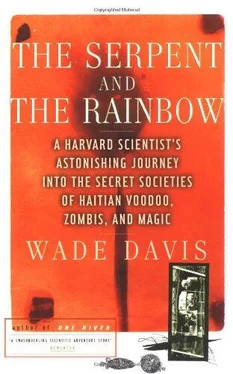Wade Davis - The Serpent and the Rainbow
Здесь есть возможность читать онлайн «Wade Davis - The Serpent and the Rainbow» весь текст электронной книги совершенно бесплатно (целиком полную версию без сокращений). В некоторых случаях можно слушать аудио, скачать через торрент в формате fb2 и присутствует краткое содержание. Год выпуска: 1985, Издательство: Simon & Schuster, Жанр: Старинная литература, на английском языке. Описание произведения, (предисловие) а так же отзывы посетителей доступны на портале библиотеки ЛибКат.
- Название:The Serpent and the Rainbow
- Автор:
- Издательство:Simon & Schuster
- Жанр:
- Год:1985
- ISBN:нет данных
- Рейтинг книги:5 / 5. Голосов: 1
-
Избранное:Добавить в избранное
- Отзывы:
-
Ваша оценка:
- 100
- 1
- 2
- 3
- 4
- 5
The Serpent and the Rainbow: краткое содержание, описание и аннотация
Предлагаем к чтению аннотацию, описание, краткое содержание или предисловие (зависит от того, что написал сам автор книги «The Serpent and the Rainbow»). Если вы не нашли необходимую информацию о книге — напишите в комментариях, мы постараемся отыскать её.
The Serpent and the Rainbow — читать онлайн бесплатно полную книгу (весь текст) целиком
Ниже представлен текст книги, разбитый по страницам. Система сохранения места последней прочитанной страницы, позволяет с удобством читать онлайн бесплатно книгу «The Serpent and the Rainbow», без необходимости каждый раз заново искать на чём Вы остановились. Поставьте закладку, и сможете в любой момент перейти на страницу, на которой закончили чтение.
Интервал:
Закладка:
In Japan, apparently, it had already happened. One physician reported:
A dozen gamblers voraciously consumed fugu at Nakashimamachi of Okayama in Bizen. Three of them suffered from poisoning; two eventually died. One of these being a native of the town was buried immediately. The other was from a distant district … under the jurisdiction of the Shogun. Therefore the body was kept in storage and watched by a guard until a government official could examine it. Seven or eight days later the man became conscious and finally recovered completely. When asked about his experience, he was able to recall everything and stated that he feared that he too would be buried alive when he heard that the other person had been buried.
What happened to the unfortunate individual who was buried is not explained. The second case was equally dramatic.
A man from Yamaguchi in Boshy suffered from fugu poisoning at Osaka. It was thought that he was dead and the body was sent to a crematorium at Sennichi. As the body was being removed from the cart, the man recovered and walked back home. As in the case previously cited, he too remembered everything.
These two cases were by no means unique. In fact such incidences are apparently frequent enough that in some parts of Japan a person declared dead from eating puffer fish is customarily allowed to lie alongside his or her coffin for three days before burial. On Christmas Eve 1977 a forty-year-old resident of Kyoto was admitted to a hospital after being poisoned by fugu. The patient soon stopped breathing, and all symptoms were consistent with brain death. Physicians immediately initiated artificial respiration and other appropriate treatments. These did not help, but twenty-four hours later the patient spontaneously began to breathe. He eventually recovered completely, and later remembered hearing his family weeping over his still body. His senses were unimpaired. He wanted desperately to let them know that he was alive, but he was unable to. “That,” he later told medical investigators, “was really hell-on-earth.”
These reports cast the zombi investigation in a totally different light. Suddenly it seemed not only possible but likely that Marcel’s poison could cause a state of apparent death. Now a dozen more specific questions came to mind. Did the species of puffers used by Marcel contain the critical toxin? If so, could they have survived the preparation? Recall that Marcel had placed the dried fish on a charcoal grill and broiled them to an oily consistency; heat destroys many chemical compounds. What about the way the zombi poison was reputedly applied? How would the bokor assure that the victim did not die from the poison? Once again, many of these questions could be answered from the literature.
Marcel added two species of puffers to his poison— Diodon hystrix and Sphoeroides testudineus—both known to contain tetrodotoxin. It was a species of Diodon that poisoned the Dutch sailors on the Postilion as it rounded the Cape of Good Hope. Members of the genus Sphoeroides are closely related to the Japanese fugu fish, and are known to be particularly virulent. In the mid-1950s an elderly tourist in south Florida ate the liver of Sphoeroides testudineus . Forty-five minutes later she died, after suffering all the horrible symptoms of the disease. Clearly, the species Marcel had used could contain tetrodotoxin.
Other answers were suggested by a remarkable account handed down by the Mexican historian Francisco Javier Clavijero. In 1706, while searching for a new mission site in Baja California, four Spanish soldiers came upon a campfire where indigenous fishermen had left a roasted piece of the liver of a botete (Sphoeroides lobatus) . Despite the warnings of their guides, the soldiers divided the meat. One of them ate a small piece, another chewed his portion without swallowing, and the third only touched it. The first died within thirty minutes, the second shortly thereafter, and the third remained unconscious until the next day.
Two critical points came across. That the soldiers were poisoned by roasted meat exemplifies the important fact that heat—frying, boiling, baking or stewing—does not denature tetrodotoxins. Secondly, although tetrodotoxin is one of the most poisonous chemicals known, like any drug its effects depend on dosage and the way it is administered. Having studied over a hundred cases of tetrodotoxication, the Japanese investigators Fukada and Tani distinguished four degrees of poisoning. The first two they characterized by progressive numbing sensations and the loss of motor control; the equivalent, perhaps, of having one’s entire body “fall asleep.” The third degree includes paralysis of the entire body, difficulty in breathing, cyanosis, and low blood pressure—all suffered while the victim retains clear consciousness. In the final degree, death comes very quickly, as a result of complete respiratory failure. If the poisonous material is ingested, the onset of the third degree is usually very rapid. The sailors on the Postilion typically died within seventeen minutes. If tetrodotoxin somehow enters the bloodstream directly its potency is enhanced forty to fifty times. However, tetrodotoxin is also topically active, and some of the preliminary symptoms have shown up in individuals who merely handle the toxic organs. In other words, whether or not the victim of the zombi poison survived would depend on just how he or she was exposed to the poison.
Marcel had recognized the potency of his preparation and had acknowledged at least implicitly the importance of proper application and correct dosage. He most emphatically stated that it was never placed in the victim’s food. Now I understood why. Ingested orally it would more than likely kill the victim; applied repeatedly to the skin or open wounds, or blown across the face of the victim so that it was inhaled, it could bring on a state of apparent death.
One final point was critical. Those who are poisoned by tetrodotoxin generally reach a crisis after no more than six hours. If the victim survives that period, he or she may expect a full recovery, at least from the effects of tetrodotoxin. This made it at least theoretically possible for a poison victim to appear dead, be hastily buried, and then recover in the coffin.
The implications of these conclusions were extraordinary. Here was a material basis for the entire zombi phenomenon—a folk poison containing known toxins fully capable of pharmacologically inducing a state of apparent death. That the peculiar symptoms described by Clairvius Narcisse so closely matched the quite particular symptoms of tetrodotoxin poisoning suggested that he had been exposed to the poison. If this did not prove that he had been a zombi, it did, at least, substantiate his case. And there was one more especially haunting fact. Every indication pointed to the possibility that Narcisse had remained conscious the entire time. Totally paralyzed, he may have been a passive observer of his own funeral.
As soon as I had these results I contacted Nathan Kline and, on his instructions, forwarded an unmarked sample of the poison to a Professor Leon Roizin at the New York State Psychiatric Institute. The next step was straightforward. Before initiating an expensive series of chemical studies, Roizin would see what the powder could do to laboratory animals. To avoid any possible bias in the experiments, I told Roizin neither what the powder contained nor what it was reputedly used for. He was merely instructed to prepare an emulsion and apply it topically to the animals. I heard from him within a week. He had worked very fast, and was ready to see me.
The elevator opened onto a congested hall that smelled of laboratories. I took a few steps along the short corridor and paused, flanked on both sides by photographic montages of monkeys under the influence of megadoses of various drugs. I was in no position to cast judgment, but I had to acknowledge that these photographs were more gruesome than anything I had witnessed in any bokor’s collections.
Читать дальшеИнтервал:
Закладка:
Похожие книги на «The Serpent and the Rainbow»
Представляем Вашему вниманию похожие книги на «The Serpent and the Rainbow» списком для выбора. Мы отобрали схожую по названию и смыслу литературу в надежде предоставить читателям больше вариантов отыскать новые, интересные, ещё непрочитанные произведения.
Обсуждение, отзывы о книге «The Serpent and the Rainbow» и просто собственные мнения читателей. Оставьте ваши комментарии, напишите, что Вы думаете о произведении, его смысле или главных героях. Укажите что конкретно понравилось, а что нет, и почему Вы так считаете.












